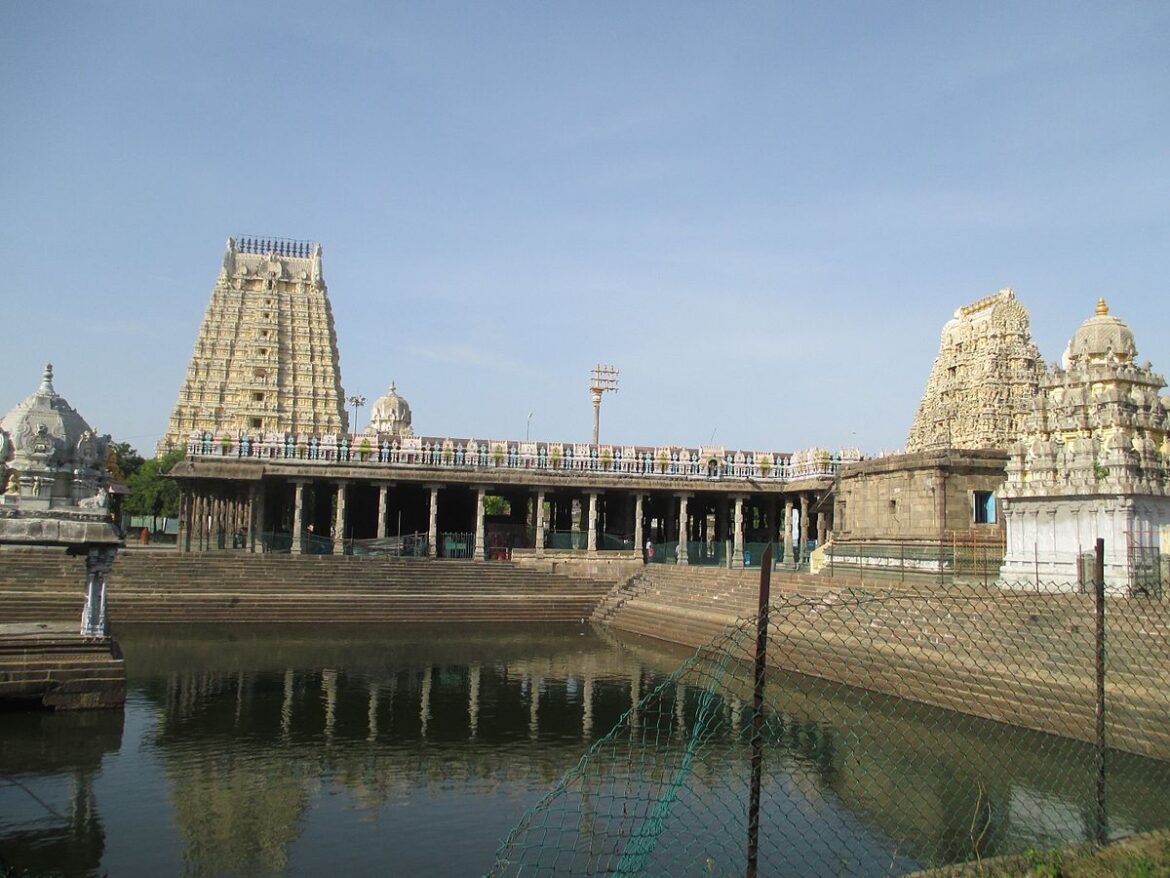- The Ekambaranathar Temple: Who Built It?
- Importance of Ekambaranathar Temple
- How To Get To The Ekambaranathar Temple
- Temples In The Neighbourhood of Ekambareshwara
- The Stunning Design of Ekambaranathar Temple
- The Perfect Time to Visit Ekambaranathar Temple
- Pooja Timings in Ekambaranathar Temple
Kanchi Ekambaranathar Temple where lord Shiva is worshipped. This shrine honors Prithvi and is considered one of the five sacred places known as stalls. Lord Shiva is worshipped at this temple, which has a Shiva lingam (also known as a Prithvi lingam) and an image of the goddess Gowri Devi by his side.
Buildings such as the Nilathingal Gundam, Perumal Temple, and Divyadesam are all part of the temple complex. The 25-acre site makes this temple one of the biggest in India. The south gopuram, at 58.5216 meters in height, is the tallest of the temple’s four gopurams and is often regarded as India’s tallest structure.
The Ekambaranathar Temple: Who Built It?
The Pallava dynasty originally constructed this temple. This enormous structure is one of India’s oldest temples. The temple has probably been around since the sixth century CE. This temple, along with the Kamakshi Amman Temple and the Varadaraja Perumal Temple, were all enlarged with the support of local kings by Adi Shankaracharya (a saint who lived in the 10th century).
The current temple building dates back to the 9th century when the Chola dynasty erected it. The Vijayanagar emperors built the latter additions. The government of Tamil Nadu is presently responsible for the temple’s upkeep and management.
Importance of Ekambaranathar Temple
The grounds of the Ekambaranathar temple span over 40 acres. Historically, kings from the Chola, Vijayanagara, and Pallava empires significantly contributed to the temple’s construction.
Lord Shiva, worshipped here as the Prithvi Lingam/Lingam of Earth, is the supreme god. Unlike the other Shiva temples in the city, Ekambaranathar has no separate shrine for the female goddess. Four prominent local Saivite Saints—Appar, Sambandar, Manickavasgar, and Sundarar—have sung the temple’s praises.
The Sthala Vruksham, a sacred mango tree, is said to be more than three thousand years old and may be seen within the temple grounds. The tree’s four trunks represent the four Vedas.
Four distinct mango varieties grow on each branch of the tree. Legend has it that Goddess Parvathi wandered away from the Lord and ended up at Ekambaranathar temple Kanchipuram. Under the mango tree, she set up a Sivalingam she had fashioned out of the sand. She resumed her relationship with Lord Shiva after worshipping Lingarm.
As one of the five components (together with Thiruvanaikaval, Kalahasti, Chidambaram, Tiruvannamalai, and Tirupati) represented in the Panchabhoota Sthalams, this is one of the holiest shrines to the Lord. The generous donations of the Vijayanagar kings are evident in the temple’s massive halls, soaring gopuram, and spacious mandapams. The Tondai area in Southern India is home to the first of 32 Tevara Stalams, and a temple is the first of the 32.
The massive gopurams are a sight when set against the temple’s skyline. The Pallavas, Cholas, and Vijayanagar emperors made important additions to this temple, most notably Krishna Deva Raya. The Pallava kings destroyed the building first, then rebuilt it. Ekambareswarar temple had significant improvements once the Cholas arrived on the scene.
The grounds of the Ekambaranathar Temple include more than 40 acres. The 172-foot tall Raja Gopuram, or gateway tower, was built by Krishnadevaraya, a king of the neighboring Vijayanagar Empire. The Vijayanagar kings also built the pillared hall before the temple’s holiest.
The Prithvi Lingam, also known as Ekambaranathar, is a form of Shiva revered by Hindus. After hearing that Parvati had a Prithivi Lingam fashioned from sand and put under a mango tree, devotees began installing a Somaskanda panel depicting Shiva, Parvati, and Skanda Mata at the rear of the main temple area, where it has remained ever since.
How To Get To The Ekambaranathar Temple
The gopuram of this 59-meter-tall temple towers over 23 acres of land. Vahana mandapam is one of them, while sarabesa mandapam is the other. Aayiram kaal mandapam is a madapam with a thousand pillars. A Vishnu temple, revered by Alvar saints, is one of the 108 Divya Desams. The Nilathingal Gundam Perumal temple is dedicated to Lord Vishu, who is given rites in the name of Vamana.
The Ekambaranathar Temple, The Mango Tree at the Ekambareswarar Temple, is over 3,500 years old and is related to mythology about Goddess Parvati doing penance there. Goddess Parvati once jokingly veiled Lord Shiva’s eyes with her fingers while he meditated.
For years, the planet was plunged into total darkness, therefore. Because of this, Shiva grew enraged with Parvati and ultimately cursed her. Goddess Parvati traveled to the city of Kanchipuram on Earth for her penance. Under a mango tree, she crafted the Earth Lingam and began worshipping it.
The Hindu goddess Parvati is said to have visited the Kanchipuram Ekambaranathar temple
and spent time meditating under this same Mango tree. The Earth Lingam was a creation of hers. The overflowing waters of the nearby Kamba River (also known as the Vegavati River) threatened to swallow the Prithvi Lingam.
The Prithvi Lingam was only preserved when the goddess Parvati embraced it. Lord Shiva appeared to Goddess Parvati because her devotion so moved him. After being enraptured by Goddess Parvati’s embrace, he wed her.
Temples In The Neighbourhood of Ekambareshwara
The Ekambaranathar Temple is close to some other temples including:
Kamakshi Amman Temple
The Hindu goddess Kamakshi Amman is honored in this temple. The enormous temple covered around 5 acres. Kanchi Kudil represents the city’s residents and is designed to give visitors a taste of what it is like to live in Kanchi.
Kailasanatha Temple
The Hindu god Shiva was honored at this temple. All around the nation, you may find his temples.
The Stunning Design of Ekambaranathar Temple
Ekambareswarar Temple’s Towering Gopurams Stand Out Against Kanchipuram’s Skyline. The total size of the temple complex is forty acres. Krishnadevaraya built the 172-foot-tall Raja Gopuram Tower at the entrance gate. He also erected a pillared hall at the entrance to the sanctum.
A passageway resembling a series of receding piers surrounds the central shrine. 63 Nayanmar sculptures can be found. Kampa Nadi and Shivaganga are two tanks found inside the temple’s grounds. Lord Vishnu, also known as Nilathingal Tundattan, has his temple. Valuable vahanams plated in silver and gold may be seen in the temple.
The Perfect Time to Visit Ekambaranathar Temple
The many events each year fill the temple with noise and activity. The Phalguni event lasts 13 days and is the most significant Lord Shiva or Lord Ekambareswar temple event. During this occasion, worshippers celebrate the union of Shiva and Parvati.
How to Reach Ekambaranathar Temple
By Airport:
About 75 km from Kanchipuram lays Chennai, where you will find the nearest international airport. There are facilities at the airport for both public and private transit.
By Railways:
Kanchi Ekambaranathar temple is also accessible by railway. However, only a small number of South Indian trains make stops there. You may get a frequent suburban rail from Kanchipuram to the beach in Chennai.
By Road:
You can get to Kanchipuram from just about everywhere in the nation because of its location along the Quadrilateral National Highway. Buses leave Chennai every hour or two, and you may take one. The Chennai Metropolitan and the State Express Transport provide those services.
Pooja Timings in Ekambaranathar Temple
| Days | Pooja Details | Pooja Timings |
| Mon to Sun | Koo Pooja | 06:00 |
| Mon to Sun | Ukshakala Pooja | 06:30 to 07:30 |
| Mon to Sun | Kala Santhi Pooja | 07:30 to 08:30 |
| Mon to Sun | Uchikala Pooja | 11:30 to 12:00 Noon |
| Mon to Sun | Pradhosa Kaalam | 17:00 to 17:30 |
| Mon to Sun | Sayaratchai Pooja | 18:00 to 19:00 |
| Mon to Sun | Arthajama Pooja | 20:00 |
Conclusion
Kanchipuram, Tamil Nadu, India, is home to the famous Hindu temple, the Ekambareswarar Temple, dedicated to the deity Shiva.
For more trending destinations please visit Bong Trekker
FAQ’s
How do I get to the Ekambaranathar Temple in Kanchipuram?
The Ekambaranathar Temple is located in Kanchipuram, which is easily accessible by road from nearby cities and towns. Regular buses and taxis are available for transportation.
What is the historical significance of the Kanchi Ekambaranathar Temple?
The Kanchi Ekambaranathar Temple is one of the oldest and largest temples in Kanchipuram, with a rich historical and cultural heritage. It is dedicated to Lord Shiva and holds immense religious importance.
Are there any dress code requirements for visiting the temple?
Visitors are advised to dress modestly and respect the religious significance of the temple. It is recommended to wear traditional attire and avoid wearing shorts, sleeveless tops, or revealing clothing.
Can I take photographs inside the temple premises?
Photography regulations may vary, but in general, photography inside the temple may be restricted. It is advisable to check with the temple authorities or signage for specific rules regarding photography.
Are there any specific timings for temple visits?
Yes, the temple has specific opening and closing timings. It is recommended to visit during the designated hours to ensure entry and a peaceful experience. Timings may vary on festival days.
Are there any nearby attractions or places of interest to visit in Kanchipuram?
Kanchipuram is known for its rich cultural and architectural heritage. Apart from the Ekambaranathar Temple, visitors can explore other temples, silk weaving centers, and historical sites such as Kailasanathar Temple, Varadharaja Perumal Temple, and Kamakshi Amman Temple.
Are there any rituals or festivals celebrated at the Ekambaranathar Temple?
The Ekambaranathar Temple hosts various rituals and festivals throughout the year. Some popular festivals include Maha Shivaratri, Brahmotsavam, and Panguni Uthiram. These festivities attract devotees from far and wide.
Is there an entry fee to visit the temple?
Entry to the Ekambaranathar Temple is generally free. However, there may be separate charges for certain special darshans or specific rituals.
Are there any specific rules or guidelines to follow while inside the temple?
Visitors are expected to maintain silence, remove footwear before entering the temple, and adhere to the instructions provided by the temple authorities. It is important to respect the sanctity of the temple and its customs.
Can I receive a priest-guided tour or participate in any rituals at the temple?
Yes, visitors can usually avail priest-guided tours and participate in various rituals at the Ekambaranathar Temple. It is advisable to inquire at the temple office or with the priests regarding specific rituals or guided tours available.

